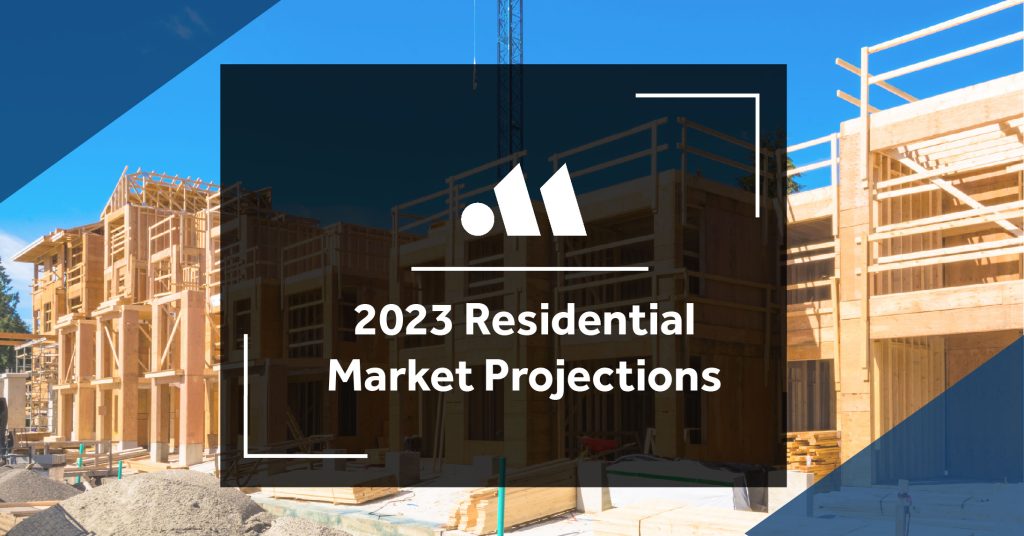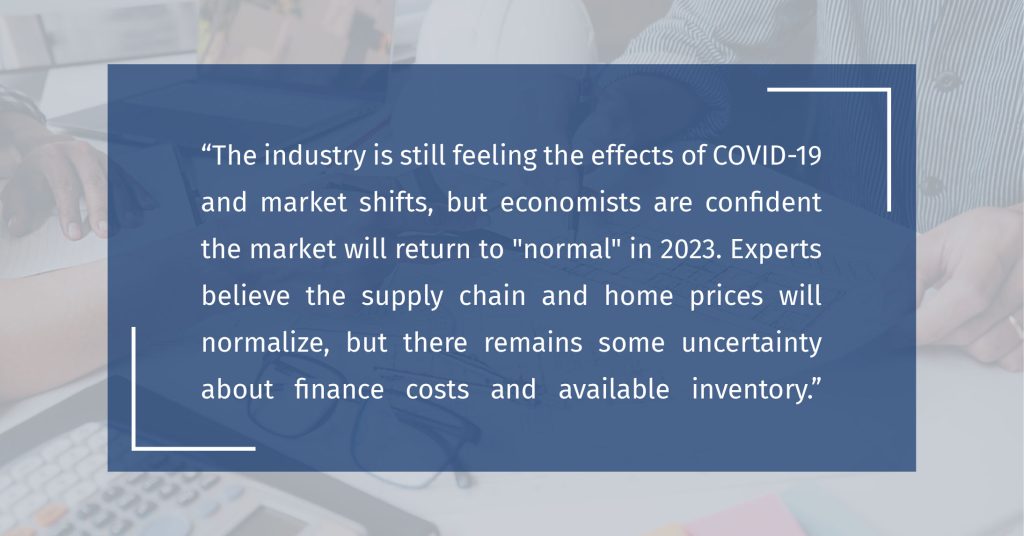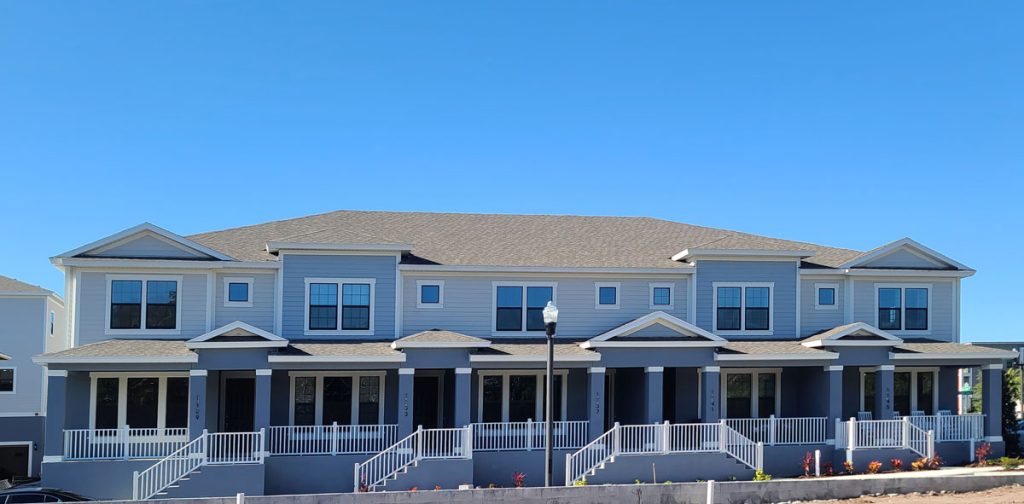
The residential industry has been nothing short of an anomaly for the last two years. In 2018 and 2019, expert economists predicted a slight recession based on historical time cycles and current market performance. Then the pandemic happened. The unprecedented global movement to control the spread of COVID-19 sent the world into survival mode and influenced government policies that changed consumer behavior, perhaps forever. The MCD 2023 residential market projections explain what has lead to the industry to its current condition and what builders should be focusing on now.
Cause
In an effort to avoid the financial crisis of the Great Depression and the Great Recession, the Federal Reserve implemented policies to increase business spending for job creation and re-employment due to the impact of mandatory lockdowns and an unemployment rate of 14.7%. Federal stimulus packages were issued to businesses and individuals, interest rates were lowered, and infrastructure spending was increased. Many states compounded efforts with rent moratoriums and other assistance programs.
The United States returned to a semblance of normalcy in the workplace within six months of the initial lockdowns. However, the aftermath of the cash influx and stimulus programs, combined with consumer uncertainty and fear from the pandemic, heavily influenced the residential markets. People adapted to the “new normal” by leaving urban areas and flocking to the metro or suburban regions in more desirable climates and markets. The migration patterns, mixed with supply chain shortage and delays, caused demand to outweigh supply. As a result, the market value of homes and rents rose at a record-breaking rate in many places throughout the United States.
Effect
The global events of 2020 through mid-2022 were the perfect storm for a housing bubble. With inflation outpacing income, there was growing concern about the “missing middle” and middle-class working families being priced out of the housing market. Inflation is still evident throughout the economy and includes rapid increases in fuel, groceries, and other necessities. As a result, in the second half of 2022, the Federal Reserve began to raise interest rates dramatically to curb inflation. Historically, this approach is known to “cool” the market; however, the full ramifications are not evident until up to 18 months after the rate change.
The industry is still feeling the effects of these events and market shifts, but economists are confident the market will return to “normal” in 2023. Experts believe the supply chain and home prices will normalize, but there remains some uncertainty about finance costs and available inventory. Below, each of those predictions is discussed in more detail.
2023 Challenges
Finance Costs
Mid-2022 inflation peaked at 9%, and the Federal Reserve anticipated raising interest rates as high as 8% by the end of the year, stating they would continue to do so until inflation corrected itself. Towards the end of 2022, the inflation rates began to level out, and interest rates rose to 4.75%. However, inflation is still higher than the Federal Reserve’s goal of 2.5%, and interest rates are expected to continue to climb in smaller increments until June of 2023. Kipligner, February 14, 2023
The rise in rates has negatively impacted mortgage costs, meaning home buyers cannot afford the same home they could buy when the market was at low-interest rates in 2020 and 2021. This change makes it difficult for entry-level buyers as they are finding it even more challenging to enter the market. In addition, consumer confidence hit an all-time low by the end of 2022. This measure indicates that repeat home buyers will be more likely to “wait and see” how the market responds before making a move.

Inventory
Because homeowners are less likely to sell, existing inventory is not slated to grow and will slightly decline by 7%. In addition, builders will not assume the risks of unfavorable financing and uncertain market conditions to increase inventory. The new construction shortage is predicted to cause a 12% inventory deficit. In fact, many residential builders have made conservative production estimates for 2023, especially the first half of this year. Inventory will not rebound until the interest rates, inflation, and consumer confidence are corrected, which predicted to be in the second half of 2023. National Association of Realtors Florida, February 2023
2023 Return to “Normal”
Supply Chain
The industry moved forward despite the logistical challenges during the last two years. With the market on the way to returning to normal, it will give a chance for manufacturers to fulfill backlogs and stabilize. Lumber prices have returned to pre-pandemic levels, but builders continue to struggle with electrical components, doors, and windows. At this point, supply chain issues are not due to raw material shortages but labor shortages. As a result, the industry will need to find labor solutions for the next decade to avoid continuing supply shortages.
Home Prices
After record equity gains, the “NAHB forecasts that home prices could fall as much as 15% in 2023.” Although this statistic is alarming on the surface, it is a year over year comparison. Even with the predicted decrease, most homeowners can expect a 30-40% post-COVID equity gain overall.
Consumer spending capacity and confidence will ultimately drive the decrease in home prices. “Leer pointed out this is a sign that consumers have been pushed to the brink and have to pull back on spending as higher expenses erode their savings and sense of financial stability. “While we’re seeing in the news that inflation is starting to cool, inflation is still impacting consumers,” he said. “They still feel and see that inflation is costing them more. Consumers are under financial stress, and they’re trying to downsize their spending.” The upside is this consumer behavior will inadvertently drive home prices down to a more affordable price that aligns with income. When the market does return to “normal”, there will likely be a surplus of consumers ready to buy a home. Florida Realtors, January 2023
2023 Residential Market Projections
Single-Family
As mentioned, overall real estate home sales are predicted to decrease by 7% while new construction starts will reduce by 12%. These statistics are based on national performance, and some markets are believed to experience improved performance. Markets to pay close attention to that will be more resilient to these shifts because of population growth include Florida, Texas, Utah, Idaho, North Dakota, Nevada, Colorado, Washington, Arizona, and South Carolina.
Multi-Family
Historically, as the single-family market cools, the multi-family market expands. Due to the increasing cost of purchasing a home, people will opt to rent, driving the demand for multi-family up. There is also a backlog of product due to supply chain shortages that stakeholders aim to complete before the end of 2023, which will add 2.6% to the total inventory. As the cost to borrow rises, investors will likely wait until mid-year to reconvene, which will cause a slight dip in unit starts for 2023. Because of finance costs, there will be an influx of smaller multi-family projects that are high quality in premium locations for a higher return on investment. CBRE, December 2022

Affordable Housing
Even though small reductions in unit starts are slated for 2023, the demand for housing will not decrease. One key factor to consider moving forward is the remaining deficit of 3.8 million housing units throughout the United States. More attention is now being directed to affordable housing solutions. Federal and local governments now offer subsidies and incentives for affordable and workforce housing solutions. In addition, large private employers are increasing their participation in making housing investments for recruiting and retention purposes. As a result, creative and efficient housing solutions will take form as more people are squeezed out of the ownership and rental market. CBRE, December 2022
Remodel
History also tells us that remodeling typically increases as the real estate market slows. The remodeling market is predicted to perform better than new construction but will experience a dip compared to the year-over-year performance. During the pandemic, there was a surge in remodels as homeowners repurposed and improved their homes to be more suitable to the pandemic lifestyle. This movement was compounded by low interest rates that encouraged refinance for remodeling. With the refinance costs surging, smaller remodels will lead the market until interest rates level out.
A type of remodel that will continue thriving is accessory dwelling units, or “ADU’s”. An ADU is a small structure that is added to an existing home or property that is suitable for 1-2 people to live. As the cost-of-living rises, families are turning to multi-generational living arrangements and ADU’s are the perfect solution for aging parents or returning young adults.
Build to Rent
An additional development model that is flourishing and will continue to grow is build to rent. In this type of community, the developer or builder constructs single-family units for rent and retains ownership. This market is slated for growth as consumers desire a suburban lifestyle but will not enter the market due to finance costs. It is considered a “safer”, long-term solution as the renters are not dependent on the unpredictable financial decisions of an individual lessor.
Overall, residential markets and United States are in a “wait and see” mode until financing options stabilize. The correction is predicted to happen by mid-year in 2023, returning to “normal” by 2024. As builders and suppliers use the next six months to fulfill backlogs, they should also plan for what the market will look like when it resurges. Monta Consulting & Design is already witnessing a demand for higher quality from buyers and various jurisdictions. The trend is expected to expand, making this the opportune time for industry professionals to develop or improve option choices and product lines in preparation for the second half of 2023. Specific tasks builders and developers should consider focusing on over the next six months are:
Product line re-development
New product line development
Troubleshooting underperforming designs
Infill projects
Option expansion
Monta Consulting & Design is well-versed in every residential market segment. Our team is intentional about staying informed of market trends and brings over 30 years of experience to the table. Whether you are a developer, builder, or homeowner, contact our team to help you design your next project for market success.




